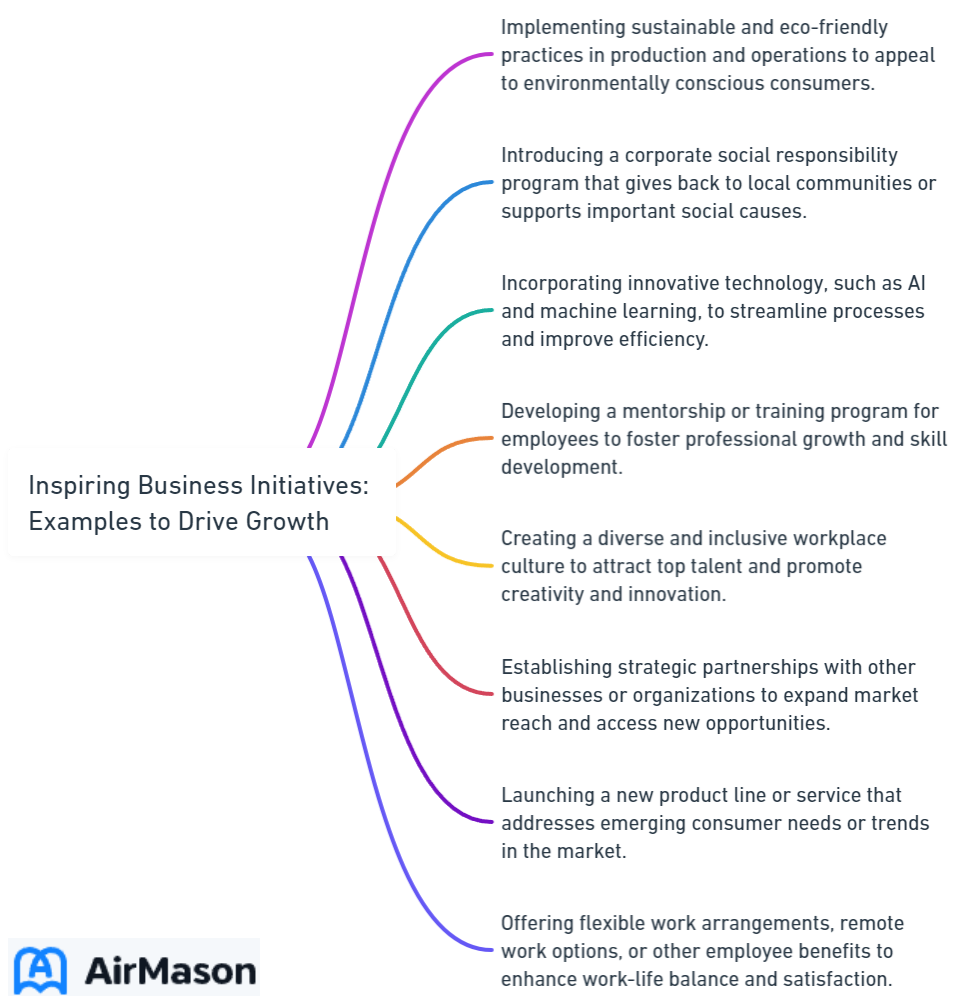
Inspiring business initiatives play a crucial role in driving growth and success for organizations. These initiatives encompass various strategies and actions that aim to bring about positive change and innovation within a business. By implementing inspiring business initiatives, companies can not only create a positive impact on their bottom line but also make a difference in society and build a reputable brand.
Business leaders are pivotal in driving growth and success through strategic decision-making and prioritizing initiatives that propel the organization forward.
Business initiatives can be defined as proactive measures and projects undertaken by organizations to achieve specific goals and drive growth. They can range from adopting sustainable practices to fostering employee empowerment and implementing innovative technologies. Business initiatives are essential for organizations as they provide a roadmap for growth, enhance competitiveness, and drive overall success in a rapidly evolving business landscape.
Inspiring business initiatives are particularly important as they serve as catalysts for positive change and transformation within organizations. They inspire employees, stakeholders, and customers alike, creating a sense of purpose and motivation. By implementing initiatives that align with their values and goals, businesses can foster a positive work culture, attract top talent, and enhance customer loyalty.
There are several benefits to implementing inspiring business initiatives. These initiatives can lead to increased revenue and profitability by tapping into new markets, attracting more customers, and differentiating from competitors. Inspiring initiatives can build a strong brand reputation, improve customer satisfaction, and generate positive word-of-mouth.
There are numerous examples of inspiring business initiatives that have yielded significant results. Some notable examples include corporate social responsibility initiatives that focus on giving back to the community, innovation and technology initiatives that drive product development and market disruption, sustainability initiatives that promote environmental responsibility, employee empowerment initiatives that promote a positive work culture, and customer experience initiatives that enhance the overall customer journey.
Inspiring business initiatives drive growth through various mechanisms. Firstly, these initiatives can directly impact revenue by opening new opportunities, attracting more customers, and increasing sales. Secondly, inspiring initiatives contribute to building a strong brand reputation, establishing credibility, and gaining customer trust. A reputable brand is more likely to attract customers, retain them, and benefit from positive brand advocacy.
To implement inspiring initiatives successfully, businesses must follow a few key steps. They should identify relevant areas within their organization where initiatives can make a significant impact. This involves understanding the needs and preferences of stakeholders and aligning initiatives with the organization’s mission and values. Next, businesses should create a clear vision and strategy for their initiatives, outlining measurable goals and objectives. Finally, allocating resources, setting performance metrics, and regularly evaluating and adjusting the initiatives’ progress is crucial to ensuring their success.
Here are several inspiring examples of business initiatives that have successfully driven growth:
- Customer Loyalty Programs: Many companies implement customer loyalty programs to incentivize repeat purchases and cultivate strong relationships with their customers. These programs often offer rewards, exclusive discounts, or personalized experiences to encourage customer loyalty and drive growth.
- Social Responsibility and Sustainability: Businesses that prioritize social and environmental responsibility can attract customers who align with their values. Initiatives such as using sustainable materials, reducing carbon footprints, or supporting community projects not only contribute to a better world but also enhance brand reputation and drive growth.
- Digital Transformation: Embracing technology and implementing digital strategies can revolutionize businesses. Examples include developing e-commerce platforms, adopting digital marketing techniques, or leveraging data analytics to gain valuable insights and optimize operations, ultimately driving growth and improving customer experiences.
- Innovation and Product Development: Companies that invest in innovation and continuously develop new products or services can stay ahead of the competition and attract new customers. By identifying unmet needs or improving existing offerings, businesses can drive growth by providing unique and valuable solutions.
- Partnerships and Collaborations: Forming strategic partnerships or collaborations with other businesses can create mutually beneficial opportunities for growth. Joint ventures, co-marketing campaigns, or sharing resources and expertise can help expand market reach, access new customer segments, and drive growth through synergy.
- Employee Empowerment: Businesses that prioritize employee empowerment and foster a positive work culture often experience increased productivity and innovation, leading to growth. Initiatives such as flexible work arrangements, professional development opportunities, and recognition programs can motivate employees and drive overall business success.
- Personalized Customer Experiences: Tailoring products, services, and marketing efforts to individual customer preferences can significantly impact growth. By leveraging customer data and implementing personalization strategies, businesses can create unique and memorable experiences that drive customer loyalty, repeat purchases, and positive word-of-mouth.
- Expansion into New Markets: Seeking opportunities for expansion into new markets, whether locally or internationally, can drive significant growth. This could involve opening new locations, targeting untapped customer segments, or adapting products and marketing strategies to meet the needs of different markets.
These inspiring business initiatives demonstrate the potential for driving growth through various strategies and approaches. By adapting and implementing these examples to suit their own contexts, businesses can ignite growth and achieve long-term success.

What Are Strategic Business Initiatives?
Business initiatives drive growth and bring innovation to organizations, aligning closely with the company’s business strategy to maintain discipline and focus. In this section, we’ll explore the essence of these initiatives and why they matter. From defining what business initiatives are to understanding their importance, we’ll uncover how organizations leverage these strategies to remain competitive in today’s dynamic market. Company initiatives play a crucial role in achieving specific goals and aligning with the company’s core values, essential for adapting, improving, and developing the company. Furthermore, aligning strategic priorities with these initiatives ensures they contribute meaningfully to the organization’s mission and values, guiding decision-making towards long-term success. So, let’s dive in and unlock the power of business initiatives!
Defining Business Initiatives
Business initiatives can be defined as strategic actions or plans taken by companies to achieve specific goals and objectives. Defining business initiatives is crucial for companies aiming for long-term and sustainable growth. These initiatives are designed to drive growth and improve overall performance, encompassing a wide range of activities and strategies that are implemented to address various aspects of a business.
To develop strategic initiatives within the framework of OKRs, it’s vital to outline a process that not only creates but also executes these initiatives, ensuring they align with the organization’s strategic goals. This approach emphasizes the importance of aligning initiatives with key results, tracking progress, and maintaining alignment with the organization’s strategic objectives.
Business initiatives are important because they provide a clear direction and focus for the organization. They help businesses identify areas for improvement, set goals, and allocate resources effectively. By implementing these initiatives, companies can enhance their competitive advantage, adapt to market trends, and stay ahead of the competition.
Examples of business initiatives include corporate social responsibility initiatives, innovation and technology initiatives, sustainability initiatives, employee empowerment initiatives, and customer experience initiatives. These initiatives can vary depending on the industry and the specific goals of the company.
To implement inspiring business initiatives, companies should first identify the relevant areas where they need improvement or want to drive growth. Once identified, they can create a clear policy and procedure template for developing a vision and strategy to guide their actions. This template will facilitate efficient planning and execution while ensuring alignment with the company’s objectives.
By implementing effective growth strategies and having a clear growth strategy in place, businesses can leverage innovative technologies, optimize distribution channels, and increase sales. It is essential to understand the target audience and market trends to ensure the success of these initiatives and drive overall business growth.
Pro Tip: When defining business initiatives, it is essential to involve key stakeholders and ensure alignment with the company’s overall vision and objectives. Regularly evaluate and adapt these initiatives to changing market conditions and feedback from customers and employees.
Importance of Business Initiatives
Implementing business initiatives, including strategic initiatives, is of utmost importance for the long-term success and growth of a company. These initiatives play a vital role in providing a clear strategic direction and enabling businesses to adapt to changing market trends and meet the evolving needs of their target audience. Strategic initiatives are comprehensive plans aimed at achieving the goals and visions of a company through action-oriented, measurable, and specific plans.
One critical aspect that highlights the importance of business initiatives is their ability to drive strategic growth. By implementing effective growth strategies, businesses can significantly increase their market share and expand their customer base. These initiatives, particularly strategic objectives, help businesses identify new opportunities, create innovative technologies, and explore different distribution channels to reach a larger audience. Strategic objectives serve as specific, achievable tasks that break down the broader vision into smaller, achievable tasks, leading to a substantial increase in sales and revenue.
Another significant benefit that emphasizes the importance of business initiatives is their role in building brand reputation.
When companies prioritize initiatives such as corporate social responsibility, sustainability, and customer experience, they actively cultivate a positive image and gain the trust and loyalty of their customers. By enhancing the well-being of their customers and demonstrating proficiency in delivering exceptional products or services, these initiatives establish the business as a reputable brand in the market.
To implement inspiring business initiatives effectively, companies must first identify relevant areas for improvement. This involves analyzing market trends, understanding customer expectations, and assessing internal resources.
Once the areas for initiative are identified, businesses need to create a clear vision and strategy for implementation. This includes setting specific goals, outlining the necessary steps to achieve them, and allocating the required resources. Measuring the success of these initiatives, especially strategic initiatives, is crucial for businesses to track their progress and make any necessary adjustments.
In summary, the importance of business initiatives, including strategic initiatives and strategic objectives, cannot be overstated. They are essential for driving strategic growth, building brand reputation, and ensuring the long-term sustainability of an established business.
By implementing inspiring initiatives, businesses can effectively drive growth, adapt to market changes, and meet the needs of their target audience.

Examples of Inspiring Business Initiatives
Discover a world of inspiring business initiatives that drive growth and make a positive impact. From corporate social responsibility to innovation and technology, sustainability to employee empowerment, enhancing the customer experience, and strategic marketing initiatives aimed at solving problems or achieving specific marketing goals through careful prioritization and selectivity, this section will immerse you in a wealth of examples that will leave you inspired and ready to take your business to new heights!
1. Corporate Social Responsibility Initiatives
When it comes to driving growth and making a positive impact, corporate social responsibility initiatives play a crucial role for businesses. These initiatives focus on addressing social and environmental issues through various activities and programs. Here are some examples of corporate social responsibility initiatives:
- Charitable Giving: Businesses can donate a portion of their profits to charities or establish their own foundations to support causes they believe in.
- Volunteer Programs: Encouraging employees to engage in volunteering activities can create a positive image for the company and contribute to the betterment of society.
- Sustainability Efforts: Implementing eco-friendly practices, such as reducing waste and carbon emissions, can help preserve the environment and promote a sustainable future.
- Ethical Sourcing: Ensuring that the company’s supply chain follows fair labor practices and supports local communities can enhance the company’s reputation and contribute to economic development.
- Diversity and Inclusion: Promoting a diverse and inclusive workplace culture through hiring practices, equal opportunity policies, and employee resource groups can foster innovation and attract top talent.
By prioritizing corporate social responsibility initiatives, businesses can build meaningful connections with their customers, employees, and the community at large. These initiatives not only have a positive impact on society but also contribute to long-term business growth.
2. Innovation and Technology Initiatives
When it comes to driving growth in business, innovation and technology initiatives play a crucial role. Here are some examples:
- Investing in research and development: By allocating resources to research and development, businesses can stay at the forefront of innovation and develop new technologies that can give them a competitive edge.
- Implementing automation systems: Automation can streamline processes and increase efficiency, allowing businesses to produce and deliver goods or services more quickly and with fewer errors.
- Adopting digital marketing strategies: In today’s digital age, businesses need to embrace technology to effectively reach their target audience. Utilizing digital marketing tools such as social media advertising and search engine optimization can help increase brand visibility and attract more customers.
- Embracing data analytics: By leveraging data analytics tools and techniques, businesses can gain valuable insights about their customers and market trends. This information can be used to make informed business decisions and develop strategies that drive growth.
- Exploring new distribution channels: Innovation and technology initiatives can involve exploring new ways to distribute products or services. For example, businesses can partner with online marketplaces or develop their own e-commerce platforms to reach a wider customer base.
Implementing these innovation and technology initiatives can lead to long-term strategic growth for businesses. By embracing new and innovative technologies, businesses can increase their sales, improve their market position, and achieve sustainable growth.
3. Sustainability Initiatives
When it comes to driving growth and ensuring long-term success, sustainability initiatives play a crucial role. These sustainability initiatives not only benefit the environment but also have a positive impact on a company’s reputation and profitability. Here are some examples of sustainability initiatives that businesses can implement:
- Implementing renewable energy sources: By transitioning to renewable energy sources such as solar or wind power, businesses can reduce their carbon footprint and contribute to a cleaner environment. This helps in creating a more sustainable energy future.
- Reducing waste and promoting recycling: Businesses can adopt practices that minimize waste generation and encourage recycling. Implementing recycling programs and providing recycling bins in the workplace can help reduce the amount of waste sent to landfills.
- Using sustainable materials: Businesses can choose to use environmentally friendly materials in their products or packaging. For example, using biodegradable or recyclable materials can help reduce the environmental impact and promote a circular economy.
- Promoting responsible supply chain practices: Ensuring that suppliers follow ethical and sustainable practices is an important aspect of sustainability initiatives. Businesses can work with suppliers who prioritize fair trade, responsible sourcing, and reduce their own environmental impact.
- Engaging in community initiatives: Sustainability extends beyond environmental impact and includes social responsibility. Businesses can contribute to their communities by supporting local initiatives, donating to charitable organizations, or engaging in volunteer activities that align with their values.
Implementing these sustainability initiatives not only demonstrates a company’s commitment to the environment and society but also attracts environmentally conscious consumers. It can also lead to cost savings through reduced energy usage, improved efficiency, and a positive brand image. By integrating sustainability into their operations, businesses can drive growth in a socially and environmentally responsible manner.
4. Employee Empowerment Initiatives
Employee empowerment initiatives are crucial for driving growth and success within organizations. By implementing these initiatives, businesses can boost productivity, foster innovation, and cultivate a positive work environment. Here are some examples of employee empowerment initiatives:
- Providing training and development opportunities: By investing in the growth and development of employees through training programs, workshops, and seminars, businesses can enhance their skills and expertise, leading to improved performance and increased efficiency.
- Encouraging autonomy and decision-making: By empowering employees to make decisions and take ownership of their work, businesses foster a sense of responsibility and accountability. This autonomy allows individuals to showcase their talents and contribute to the organization’s success.
- Supporting a collaborative and inclusive culture: Creating an environment that values teamwork and collaboration cultivates innovation and creativity. By encouraging employees to work together and share ideas, businesses can tap into their collective knowledge and drive growth.
- Recognizing and rewarding achievements: Acknowledging and rewarding employees for their hard work and accomplishments not only boosts motivation but also reinforces a culture of empowerment. Recognitions such as employee of the month or bonuses for outstanding performance can inspire employees to excel in their roles.
- Providing opportunities for career advancement: Businesses can motivate employees to stay committed and engaged by offering growth opportunities and career paths within the organization. This can include promotions, transfers, or the chance to lead projects or teams.
By incorporating employee empowerment initiatives, businesses can create a motivated and engaged workforce that is dedicated to achieving organizational goals and driving long-term growth. To see how this can be achieved in practice, take a look at our article featuring various policy and procedure samples, which provides a concrete illustration of how effective policies and procedures can support and sustain employee empowerment initiatives.
5. Customer Experience Initiatives
When it comes to driving growth in a business, customer experience initiatives play a crucial role. These initiatives focus on enhancing the overall experience of customers, ensuring their satisfaction, and building strong customer relationships. Here are some examples:
- Personalized interactions: Implementing personalized interactions, such as personalized emails or tailored recommendations based on customer preferences, can enhance the customer experience and strengthen their loyalty.
- Seamless omni-channel experience: Providing a seamless experience across different platforms and channels, whether it’s online, in-store, or through mobile apps, helps customers easily navigate and engage with your brand.
- Efficient customer support: Offering prompt and helpful customer support through various channels, such as live chat or 24/7 helpline, ensures that customers’ issues and concerns are addressed effectively.
- Convenient self-service options: Providing self-service options, like online FAQs or tutorials, allows customers to find solutions to their queries or problems independently, saving them time and effort.
- Engaging loyalty programs: Creating engaging loyalty programs that offer rewards, exclusive discounts, or special access to events can incentivize customers to continue purchasing from your business and increase their satisfaction.
Prioritizing customer experience initiatives is key to driving growth in a business. By implementing strategies that focus on personalization, seamless experiences, efficient support, self-service options, and engaging loyalty programs, businesses can cultivate strong customer relationships and enhance overall satisfaction, contributing to long-term success and sustainable growth.
One successful example of a company implementing customer experience initiatives is Amazon. From its early beginnings as an online bookstore, Amazon prioritized customer satisfaction, offering personalized product recommendations, hassle-free returns, and fast shipping options. Over time, Amazon expanded its services, creating an omni-channel experience that includes music and video streaming, grocery delivery, and smart devices. By consistently enhancing the customer experience, Amazon has grown to become one of the largest and most successful e-commerce companies globally.

How Do Inspiring Business Initiatives Drive Business Growth?
Discover the power of inspiring business initiatives and their role in driving impressive growth. In this section, we’ll explore two key aspects: the impact of these initiatives on revenue and their significance in building a strong brand reputation. Learn how businesses have harnessed the potential of inspiring initiatives to achieve remarkable financial success and establish themselves as industry leaders.
However, it’s crucial to address why some strategic initiatives fail, shedding light on the importance of alignment, accountability, and transparency in their execution. Misalignment between a company’s strategic goals and its initiatives, lack of accountability from team members, and insufficient transparency throughout the process can significantly hinder the success of these efforts. Understanding and addressing these common challenges is essential for any organization aiming to leverage strategic initiatives for growth.
Get ready to uncover the secrets behind the connection between inspiration and sustainable growth in the business world.
The Impact of Inspiring Business Initiatives on Revenue
The impact of inspiring business initiatives on revenue cannot be understated. Implementing effective growth strategies is crucial for the long-term success and sustainability of a business. Inspiring initiatives have the potential to drive significant revenue growth and contribute to the overall financial performance of an organization.
To fully grasp the impact of inspiring business initiatives on revenue, it is important to recognize that these initiatives play a vital role in driving sales and expanding market share. Innovative technologies and distribution channels, for instance, can broaden the reach of businesses, enabling them to capture a larger target audience and attract new customers. By embracing market trends and adapting to evolving consumer preferences, businesses can position themselves for greater sales and overall revenue growth.
It is worth noting that inspiring business initiatives can not only increase revenue but also enhance brand reputation, fostering customer loyalty and trust. By establishing a clear growth strategy and implementing initiatives that align with the values and goals of the business, companies can cultivate a positive brand image. This, in turn, leads to improved customer retention and a higher number of repeat purchases, ultimately driving revenue growth in the long run.
To maximize the impact of inspiring business initiatives on revenue, businesses need to identify relevant areas for these initiatives and establish a clear vision and strategy as part of a comprehensive strategic plan. This strategic plan is essential for aligning initiatives with the company’s long-term vision, ensuring continuous improvement, and adapting to market changes. Additionally, it is essential to allocate resources effectively and measure the success of these initiatives to ensure their contribution to revenue growth.
The Role of Inspiring Business Initiatives in Building Brand Reputation
Inspiring business initiatives have a crucial role in building brand reputation. By implementing innovative technologies, adopting sustainable practices, and focusing on customer experience, businesses can enhance their reputation and establish themselves as industry leaders.
One example of inspiring business initiatives in building brand reputation is through corporate social responsibility (CSR) initiatives. By supporting social and environmental causes, businesses not only contribute to the well-being of the community but also enhance their brand image. This can attract socially conscious customers and boost brand loyalty.
Innovation and technology initiatives are another way to build brand reputation. By staying ahead of market trends and implementing cutting-edge technologies, businesses can demonstrate their commitment to delivering quality products and services. This can establish them as industry innovators and attract customers seeking the latest solutions.
Sustainability initiatives also contribute to building brand reputation. By adopting sustainable practices, such as reducing carbon footprint and promoting eco-friendly packaging, businesses show their dedication to environmental preservation. This resonates with environmentally conscious consumers and helps build a positive brand image.
Employee empowerment initiatives can also enhance brand reputation. By investing in employee training and development programs, businesses cultivate a skilled and motivated workforce. This translates to improved customer service and overall customer satisfaction, leading to a positive brand image.
Inspiring business initiatives play a vital role in building brand reputation. By adopting strategies that prioritize social responsibility, innovation, sustainability, and employee empowerment, businesses can establish themselves as reputable brands in the long run.

How Can Businesses Implement Inspiring Initiatives?
When it comes to driving growth, inspiring business initiatives play a crucial role. In this section, we’ll explore how businesses can effectively implement these initiatives. From identifying relevant areas for initiative to creating a clear vision and strategy, and allocating resources while measuring success, we’ll uncover the key steps that can elevate businesses towards their growth goals. So, get ready to discover the strategies that can ignite inspiration and propel businesses towards success!
Identify Relevant Areas for Initiative
Identify relevant areas for initiative is a crucial step in implementing effective growth strategies for businesses. By focusing on specific areas that have the potential for long-term strategic growth, businesses can maximize their efforts and resources.
1. Market Trends Determine the current trends and demands in the market. Identify relevant areas for initiative where there is a gap or an opportunity for growth. This could be a new emerging market, changing consumer preferences, or technological advancements. 2. Target Audience Understand the needs and preferences of your target audience. Conduct market research to identify their pain points, desires, and aspirations. This will help you tailor your initiatives to meet their specific needs. 3. Distribution Channels Review your distribution channels and assess their effectiveness. Identify relevant areas for initiative where there is a need for improvement or expansion. This could involve exploring new partnerships, online platforms, or direct-to-consumer strategies. 4. Established Business Analyze the current strengths and weaknesses of your business. Identify relevant areas for initiative where you have a competitive advantage or where improvements can be made. This could include enhancing customer service, streamlining operations, or optimizing your supply chain. 5. Innovative Technologies Stay up to date with the latest technologies that can drive growth in your industry. Identify relevant areas for initiative where innovative technologies can be leveraged to improve efficiency, productivity, or enhance the customer experience.
By carefully identifying relevant areas for initiative, businesses can develop a clear growth strategy that is aligned with their goals and target audience. This allows them to allocate resources effectively, measure success, and ultimately drive sustainable growth in the long run.
Create a Clear Vision and Strategy
Creating a clear vision and strategy is crucial for the success and growth of any business. When a company undertakes the task of creating a clear vision and strategy, it sets a positive direction for the organization and helps align all stakeholders towards a common goal. Similarly, a well-defined and carefully crafted strategy outlines the specific steps and actions required to achieve that vision.
A clear vision and strategy provide numerous benefits to a business. It aids in long-term planning and decision-making processes. It enables the business to identify and focus on its strengths, opportunities, and target audience, thereby enhancing its competitive advantage. Moreover, a clear strategy allows the company to effectively allocate resources and prioritize its actions based on prevailing market trends and customer demands.
The creation of a clear vision and strategy also plays a crucial role in driving sustainable growth. It enables an established business to adapt to changing market conditions, adopt innovative technologies, and identify new distribution channels. Consequently, these factors contribute to increasing sales and expanding the customer base, ultimately leading to growth and success
To successfully create a clear vision and strategy, businesses should commence by identifying the relevant areas requiring initiatives. These areas could include product development, marketing, or customer service, among others. Once these areas are identified, the company should proceed by defining its vision statement, which outlines its long-term objectives and aspirations. Subsequently, a strategy should be developed, encompassing specific goals, action plans, and measurable targets.
The creation of a clear vision and strategy is essential for businesses seeking sustainable growth and effective growth strategies implementation. It provides a clear direction, aligns stakeholders, and facilitates efficient resource allocation. By having a clear vision and strategy in place, companies can navigate market challenges and seize opportunities for long-term success
In the world of business, inspiring initiatives often require well-defined guidelines for success. To learn more about how to craft effective policy and procedure documents to support and implement these initiatives, be sure to check out our article on how to write a policy and procedure document. This comprehensive guide will provide you with the essential tools to turn inspiration into actionable policies.
Allocating Resources and Measuring Success
Allocating resources and measuring success are vital steps in implementing inspiring business initiatives. Properly allocating resources ensures that the necessary tools, funds, and manpower are available to effectively support the initiatives. Measuring the success of these initiatives allows businesses to assess their impact and make informed decisions for future growth strategies.
- Identify areas for initiative: Prior to allocating resources, businesses must identify the specific areas where inspiring initiatives can be implemented. This may include areas such as sustainability, employee empowerment, or customer experience.
- Create a clear vision and strategy: Developing a clear vision and strategy for the initiatives helps provide direction and guidance. Businesses should define their goals, objectives, and desired outcomes to allocate resources effectively.
- Allocate resources: Once the areas and strategies are identified, businesses need to allocate the necessary resources, including budget, manpower, technology, and time. Proper allocation ensures that the initiatives have the support they need to thrive.
- Measure success: Measuring the success of inspiring initiatives is crucial in understanding their impact and effectiveness. Businesses can use key performance indicators (KPIs) to track progress, such as increased sales, customer satisfaction ratings, or cost savings.
A small retail business implemented an inspiring customer experience initiative by creating a loyalty program for their customers. They allocated resources to develop a user-friendly mobile app, trained their staff to provide exceptional customer service, and regularly measured their success through customer feedback and retention rates. As a result, the business observed a significant increase in customer satisfaction, repeat purchases, and word-of-mouth referrals. The allocation of resources and measurement of success played a vital role in the growth and success of their initiative.
Frequently Asked Questions
What are some inspiring business initiatives that drive growth?
Inspiring business initiatives that can drive growth include adopting new innovations and technologies, such as cloud-based solutions and time management tools. Strategic planning, market expansion, and product development are also vital parts of inspiring growth strategies.
How can businesses maximize their growth using existing resources?
Businesses can maximize their growth using existing resources by implementing organic growth strategies. This involves expanding through internal resources, optimizing internal processes, and increasing efficiency to generate more sales.
What role do innovation strategies play in business growth?
Innovation strategies play a crucial role in business growth as they allow businesses to adopt innovative technologies, adapt to market fluctuations, and stay competitive in a fickle consumer base. By embracing technological breakthroughs and creatively implementing new ideas, businesses can drive unprecedented increases in revenue and achieve long-term success.
How can small startups drive growth in a competitive business landscape?
Small startups can drive growth in a competitive business landscape by implementing effective growth strategies. These strategies can include market penetration through special promotions and improved customer service, digital marketing strategies, and strategic partnerships with complementary businesses to leverage each other’s strengths and customer bases.
How can mergers and acquisitions contribute to business growth?
Mergers and acquisitions can contribute to business growth by allowing companies to gain market share, access new markets, and enhance their capabilities. Through strategic collaborations, businesses can expand their reach and diversify their offerings, leading to concrete growth strategies and sustained increases in revenue.
How can businesses in the Arab world drive growth and become the next generation of leaders?
Businesses in the Arab world can drive growth and become the next generation of leaders by adopting new innovations, embracing strategic planning, and leveraging the competitive advantages of the region. By following inspiring business initiatives and adapting to the evolving business landscape, businesses can emerge as pioneers in their industries, maximizing their profits and taking on leadership roles in the global market.
